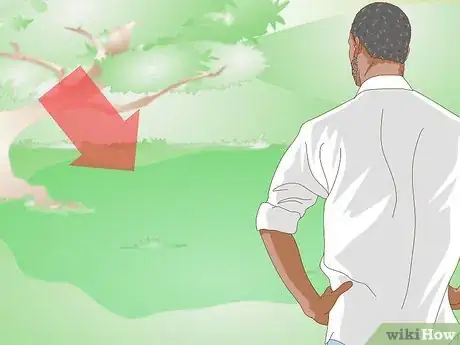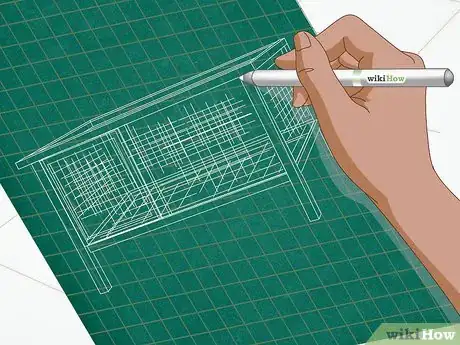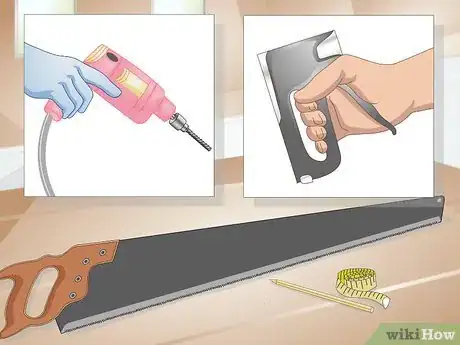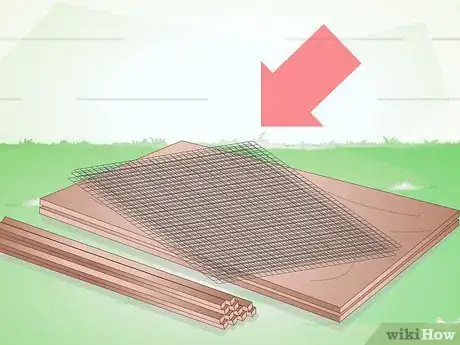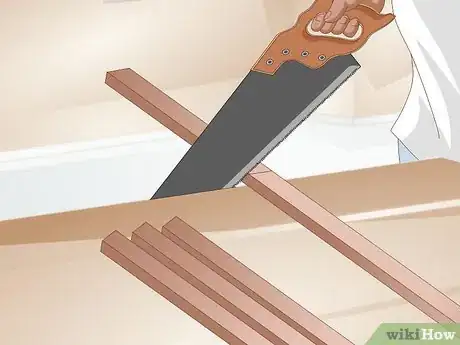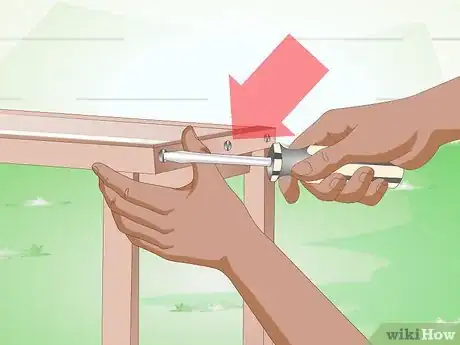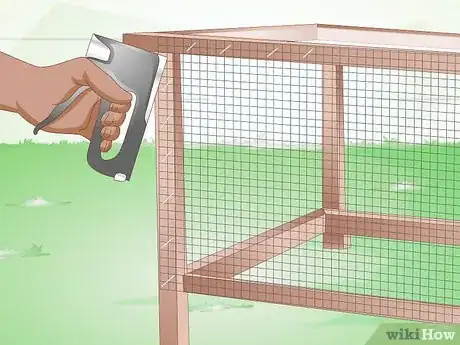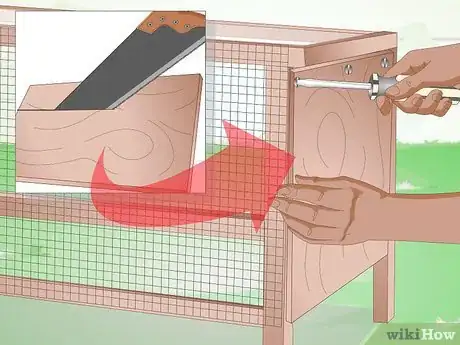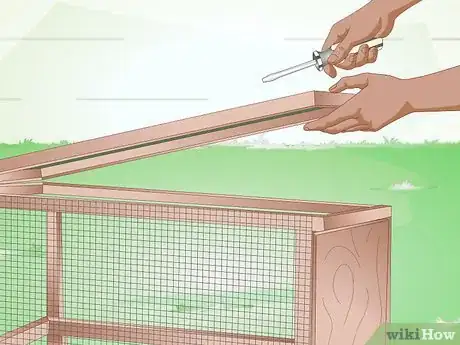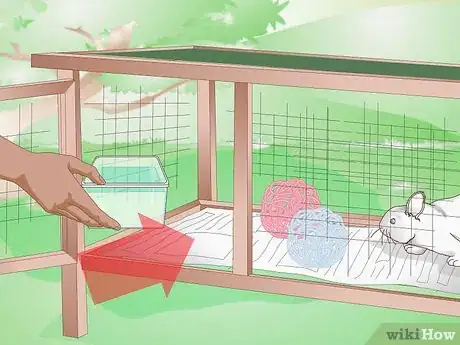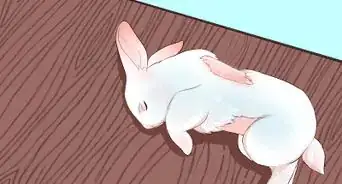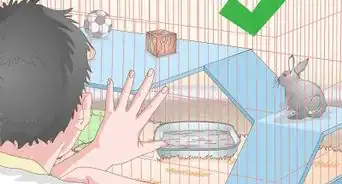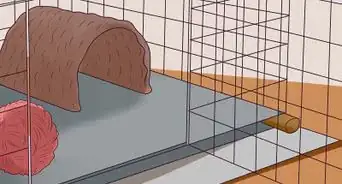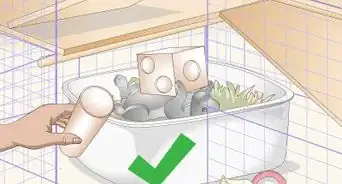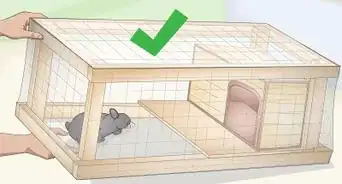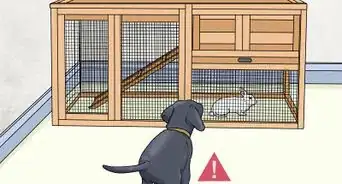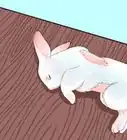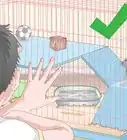This article was co-authored by wikiHow Staff. Our trained team of editors and researchers validate articles for accuracy and comprehensiveness. wikiHow's Content Management Team carefully monitors the work from our editorial staff to ensure that each article is backed by trusted research and meets our high quality standards.
This article has been viewed 156,598 times.
Learn more...
Does your rabbit need a nice space to live in outdoors? In order to construct a rabbit cage outside you will need some basic building tools and materials and some do-it-yourself know how. With a little bit of effort and time you can make a well-constructed rabbit's cage that will help your rabbit live a happy and healthy life outside for years to come.
Steps
Planning an Outdoor Rabbit Cage
-
1Find a well-shaded and protected area of your yard to place the cage in. This should be a spot that is best suited to your rabbit's needs. The location, in combination with the cage itself, will provide the shade the rabbit needs to keep from overheating in the summer and should also keep them out of bad weather in the winter.
- Rabbits can get heat stroke because they only sweat on the pads of their feet.
- The only bigger danger than heat to outdoor rabbits is cold. A heater won't work for two reasons: the rabbits will huddle to it (and are more than likely to burn themselves), and it can also start a fire.
-
2Design the cage. A basic rabbit cage, also known as a hutch, is simple a box that is raised off the ground. Standard rabbit cages are made of wood and wire, and are big enough for the rabbits to sit up on their hind legs and to stretch out.[1]
- Decide on the height, width, and depth of the box of the cage. This is a good starting point for your design. Make your enclosure at least five feet deep by six feet long and tall enough for the rabbits to not hit their fuzzy heads on the roof when they jump. If more than one rabbit inhabits the space, make it a couple feet longer.
- Decide how far off the ground the cage should be. To keep the rabbits from predators, make sure it is at least 3 feet off the ground.[2]
- The cage is usually long enough to have two sections, in order for the rabbits to have a separate sleeping section. The sleeping section should have solid sides, so that the rabbits can snuggle inside if the temperature gets cold.
- The roof of the cage can also function as its door, with the roof attached on one side with hinges, so it can be lifted up.[3] It should not be totally flat, as a pitched roof with an overhang will keep rain out more successfully.[4]
- There is no one way to design the cage but as long as the structure is secure and the inside is big enough for the rabbits, you are on the right path.
Advertisement -
3Gather tools. You will need a saw and a drill, in addition to a staple gun and some snips to cut wire mesh. The saw and drill will help you make the frame and the staple gun and snips will help you to attach the wire to the frame.
- Additionally you will need a tape measure and pencil to make measurements and mark them.
-
4Gather materials. A rabbit cage has all the basic things a house does: a roof, walls, and a floor. However, unlike a house, the roof of a rabbit cage can function as its door and the floor and some of the walls are usually made of wire mesh.
- Get wire mesh that has gaps small enough so that the rabbits can't get their heads stuck in it. Steel works well, but there are many safe varieties (just make sure it is not lead).
- You will also need enough wood to build the frame you have designed. While the size of the lumber doesn't really matter, it may be easiest to get basic 2 x 4 lumber from your local lumberyard or home improvement center. Add up all of the measurements from your design in order to figure out how much lumber you will need to build the cage frame.
- You will also need a tight metal mesh for the bottom of your cage. While much of the floor will be covered in natural bedding material, such as hay, the floor underneath should not be solid. One reason for this is that a mesh floor allows urine to leave the cage, so your rabbit isn't sitting in it.
- Materials for the roof should include plywood, roofing material, and hinges to attach the roof to the box of the cage. You will also need additional plywood to build a few solid walls on the cage.
- Alternatively, you can buy an all wire cage from a pet store and then build a frame around it. This will allow you to completely remove the wire cage from the frame in order to clean it.[5]
- Some sources even suggest using wood pallets as the wood for your cage. You will need to take the pallet apart and reuse the pieces.[6]
Constructing the Cage
-
1Cut lumber for your frame. Take the measurement of each piece from your design and then cut a corresponding piece of lumber. It may be easiest to number each piece on your design and then put the matching number on the pieces of lumber after you cut them.
-
2Fasten the lumber of the frame together. Work in an organized fashion. You can build the box of the cage first and then attach it to the supports it will sit on afterwords. Start with the box, fastening the pieces of lumber together with screws, so that the finished box is the size you desired.
- Then build the supports for the box to sit on, making sure that it is tall enough and sturdy enough to keep the box, and bunnies, upright.
- Remember that you should have an area that has solid sides, so that the rabbits can get away from cold weather and have a cozy place to sleep.[7]
-
3Cut and attach the wire mesh. Make sure to cut the pieces of mesh so that they cover each opening in the frame you built completely. You should have four side pieces and one floor piece. Once you have cut all the pieces, grab a staple gun and start attaching the wire.
- Make sure the rabbits can't slip through the gaps in the staples.
- If you decided to buy a pre-made wire cage, simply slip it into the frame that you built. Make sure that the wire cage is secure and fits correctly.[8]
-
4Cut and attach wood for solid walls. Your solid walls should be made of plywood and can be screwed directly to the framing of the cage on the outside. Your cage will need a few solid walls. The sleeping area of the hutch should have solid walls, so that your bunny can snuggle in and keep warm when the weather is cold.
- You should also put a solid wall between the main area of the cage and the rabbit's sleeping area. This will ensure that the sleeping area is a completely protected space. You can use plywood for this wall as well but you will need to cut an opening in it that the bunny can easily get through.
-
5Build and attach the roof. Cut your plywood to completely cover the top of the cage. Screw the hinges onto the plywood and then onto the frame. Add roofing material to the top of the roof, making sure that the roof will be water tight.
- You may want to put a security latch on the roof. This will keep the roof from blowing up in a strong wind or predators from opening up the top of the cage and getting your rabbits.
-
6Add bedding material, toys, and containers for food and water.[9] You want to make the cage a cozy home for the rabbits, so it needs an abundant amount of bedding and food and water in order to settle in. Toys and other amenities are a plus that will help the rabbit thrive.
- Once the hutch is all set up you can place the rabbit into its new cage.
Community Q&A
-
QuestionWhat is the ideal space per rabbit? How much space does one need for 100 rabbits?
 Community AnswerOne rabbit should have 8 hops to the other end of the cage and be able to stand up on his hind legs (legal requirements), so you should have a lot of land for that!
Community AnswerOne rabbit should have 8 hops to the other end of the cage and be able to stand up on his hind legs (legal requirements), so you should have a lot of land for that! -
QuestionShould a play area outside the hutch have a floor, or is it okay to let the rabbit roam on grass?
 Community AnswerIf your rabbit likes to dig or if they are restless, you probably want to lay a floor down. If your rabbit is easygoing and content, you're probably fine with grass. Just make sure the grass is untreated, because the toxins can make your rabbit sick, or even kill them.
Community AnswerIf your rabbit likes to dig or if they are restless, you probably want to lay a floor down. If your rabbit is easygoing and content, you're probably fine with grass. Just make sure the grass is untreated, because the toxins can make your rabbit sick, or even kill them. -
QuestionDo rabbits need a little soft bed to sleep in, or is hay okay?
 Community AnswerHay is great, and a more natural option for rabbits. They don't need a special bed.
Community AnswerHay is great, and a more natural option for rabbits. They don't need a special bed.
Warnings
- If there are raccoons, birds, or other predators in your area make sure that the wire is thick enough to stop them from getting to your bunnies.⧼thumbs_response⧽
- Rabbits require constant care and regular vet visits. You can't just put it outside in a cage and forget about it. Consider if a rabbit will be right for you or you may end up in a problem situation with your furry friend.⧼thumbs_response⧽
References
- ↑ http://www.rabbithutchesadvice.com/subjects/hutch-design-basics/
- ↑ http://rabbitbreeders.us/how-to-build-a-rabbit-hutch
- ↑ http://beprepared.com/blog/13635/diy-project-build-your-own-rabbit-hutch/
- ↑ http://www.therabbithouse.com/outdoor/rabbithutch.asp
- ↑ http://rabbitbreeders.us/how-to-build-a-rabbit-hutch
- ↑ http://www.motherearthnews.com/homesteading-and-livestock/diy-rabbit-hutch-from-wood-pallets.aspx#ixzz2UhHBq5Ac&i
- ↑ http://www.therabbithouse.com/outdoor/rabbithutch.asp
- ↑ http://rabbitbreeders.us/how-to-build-a-rabbit-hutch
- ↑ http://www.rabbithutchesadvice.com/subjects/hutch-design-basics/
About This Article
To build an outdoor rabbit cage, start by deciding on the height, width, and depth of the cage and cut the lumber. Next, build the cage frame and fasten the pieces of lumber together with screws. Then, cut the wire mesh, place it over each opening in the frame, and attach it with a staple gun. Finally, cut plywood to make the solid walls and screw them onto the frame before building and attaching the roof. For tips on the best roofing material to use, read on!
